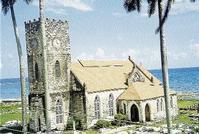
From the wattle and daub of the Tainos to the cement and steel of contemporary society, the various building designs in Jamaica define our architectural heritage, each providing vital information on the different periods of our past.
Similar to the case of some plants and animals in Jamaica, many of the 18th and 19th century buildings that are in Jamaica today have become somewhat "endangered" requiring valiant efforts to preserve what remains of their structures, which have fallen prey to the damaging effects of natural disasters, neglect, or "progress". Today, many developers, recognising the historic value of some of these abandoned buildings deemed old have put them to good use.
Over the years however, The Georgian Society of Jamaica has sought to protect and preserve many of our elegant period buildings. Formed in 1967 by Geoffrey de Sola Pinto, this heritage preservation organization is led by the mission to "stimulate interest in and promote an appreciation for the value of Jamaica's heritage," especially Georgian buildings.
Architectural Heritage
"Historic places tell us who we are as a nation and unless we all become aware of the importance of our architectural heritage and take action to preserve it, we will lose a great wealth of knowledge," stated de Sola Pinto. "We at the Georgian Society are trying to get people conscious of our architectural heritage, as these buildings were constructed by Jamaican craftsmen and should be preserved as noteworthy contributions of our own Jamaicans who toiled to produce such beautiful edifices," he continued.
For its distinguished service in heritage preservation, the Georgian Society of Jamaica was awarded the Institute of Jamaica's Silver Musgrave recently.
Georgian architecture is said to have developed in England out of the Classical Revival which dominated Europe during the Renaissance and Enlightenment
eras. This period was characterized by an enthusiasm for classical antiquity and archaeological knowledge, motivated by the excavations of Roman remains at Pompeii and Herculaneum and by the commencement of archaeological investigation in Greece by James Stuart and Nicholas Revett in 1751. The name comes from the kings of Great Britain- George I, George II, George III and George IV, who ruled England during the period that Georgian architecture was popular, from 1714 until 1830s. Buildings of Georgian design are characterized by their sense of proportion and balance. Simple mathematical ratios were used to determine, for example, the height of a window in relation to its width or the shape of a room as a double cube.
Falmouth in Trelawny is an old Georgian town of considerable merit that has been under the watchful eye of this organization for the past 40 years. Once known for its role in sugar production, this town was also popular for the beautiful Georgian buildings that lined its streets. In fact, the idea for a Georgian Society, as relayed by Pinto, was born while he and a colleague were conducting research for what they had termed "The Falmouth Restoration Project." The name change occurred when these two men got a peek at some of the beautiful Georgian buildings that defined Jamaica's architectural landscape, upon consulting the book, "Treasure in the Caribbean, A First Study of Georgian Buildings in the British West Indies" by Angus Acworth. Coincidentally the book was borrowed from the Institute of Jamaica's library.
Non-profit in nature and over 200 members strong, The Georgian Society of Jamaica operates four chapters throughout the island in Kingston, Falmouth, Montego Bay and Ocho Rios. The London-based overseas branch, The Friends of the Georgian Society of Jamaica, boasts over 120 members and was lauded by Pinto for the overwhelming financial and other forms of support they have provided the local body.
As regards their receipt of the Silver Musgrave Medal, Mr. Pinto stated, "We are extremely pleased to be receiving this award from the Institute of Jamaica, as over the years we have not received much recognition from the government."
President of the Georgian Society, Mr. George Farria echoed similar sentiments. "We are very very honoured and proud to be receiving this award. It means a lot to know that our hard work is being recognized." He however reiterated the need for increased governmental assistance and recognition to assist their effort.
Despite limited funding however, the organization has participated in several restoration projects. Listed as one of their most recent accomplishments, is the 2003 restoration of the beautifully proportioned Georgian building on Market Street in Falmouth, Trelawny which currently houses the government Post Office. The Georgian Society has also conducted several surveys on various Georgian Towns -Spanish Town, Montego Bay and St. Ann and other sites in Jamaica. One of the first class Georgian buildings mentioned by De Sola Pinto was the old Half-Way Tree Courthouse. He commended the Kingston and St. Andrew Corporation (KSAC) for the commendable work that was done in restoring the structure and for drawing on the expertise of a member of the Georgian Society who gave expert advice on preservation measures. The Richmond Park Great House in Kingston, home of the Georgian Society of Jamaica was one other first class Georgian building mentioned.
The Mission Statement of the Georgian Society of Jamaica reads: "We are committed to the preservation, restoration and maintenance of Jamaica's historic buildings, monuments, artefacts, works of art, furniture and fixtures particularly those belonging to the Georgian period - seventeen hundred and twenty to eighteen hundred and fifty (1720-1850) to causing where possible, legislation to be enacted, rescinded or altered to enable those things to be accomplished, to stimulating interest in and promoting an appreciation of the value of Jamaica's heritage."
The Society's newsletter Our Island Heritage boasts several editions which contain well researched articles featuring Jamaica's historic buildings and landmarks as well as a section aptly titled S.O.S. which highlights buildings in need of repair. A video series on old buildings will be made available to the public shortly.

